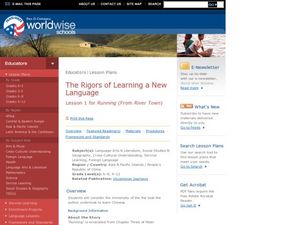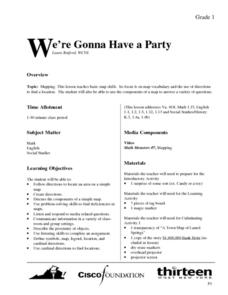Curated OER
Interdependence in a Global Community
Students locate the geographic origin of a variety of products used in our society. They find countries in an atlas or on a wall map. They define the term imports and emphasize the theme of MOVEMENT and use it to explain interdependence.
Curated OER
This Is Tanzania
Students study the volcanic history and the wildlife of Tanzania. They examine how most Tanzanians live on a subsistence agricultural economy.
Curated OER
Fresh Water and land of Kiribati and Hawaii (Molokai)
Fourth graders examine the islands of Hawaii. Using this information, they organize it and create a map or graph that represents the data. As a class, they discuss how the watersheds on the islands are different and how people react to...
Curated OER
Back to School (Secondary)
Welcome your class back to school! They will participate in a character education lesson plan in order to build community at the school. First they identify needs of new students by putting themselves in their shoes and create welcome...
Curated OER
Day to Day Life in a Small African Village
Students analyze life in a village of Tanzania including its language, geography, health, and hygiene issues. In this African village instructional activity, students locate Tanzania and its capital city on a map. Students compare...
Curated OER
What's Integrity?
Students explore the trait of integrity. In this character education lesson, students read letters by Steve Williams pertaining to jobs that help others. Students discuss the jobs WilIiams shares as well as integrity in their lives.
Curated OER
From There To Here...
Young scholars find out where some of the products in hour homes come from, then become aware of our local trash, landfills and incinerators. They chart and graph data and use maps for different purposes.
Curated OER
Creating Climographs
Students chart statistical information on graphs, interpret the information and use it to explain spatial relationships, and identify the relationship between climate and vegetation.
Curated OER
The Flow of Women's Work: How Cultures are Alike and Different?
Students examine gender roles in various cultures. In this flow of women's work lesson, students compare water related work in rural Africa to that in their own households.
Curated OER
"We Didn't Start the Fire"
Students extract geographical and historical information from the lyrics of a popular song, make associations between people, places, and events, and plot their information on a map.
Curated OER
The Eagle Has Landed: Aztecs Find a Home
Pupils examine the Aztec civilization in what is now Mexico. Using a map, they locate the empire and explain the legend of the founding of Tenochtitlan. They explore the symbols on various Mexican flags and what they meant to the Aztec...
Curated OER
WebQuest: Water, Sanitation & Health
Students examine water issues in Africa. In this global issues lesson, students complete a webquest that requires them gather information. Students use the information to prepare for a World Water Summit simulation.
Curated OER
Just Like the Old Days
Students examine customs of rural Mongolia. They read and discuss a letter, discuss families, locate Mongolia on a map, reenact scenes from the letter, and write a prediction of how life change in rural Mongolia during the next 50 years.
Curated OER
The Rigors of Learning a New Language
Young scholars examine the experiences of a Peace Corps volunteer learning to speak Chinese. They read and discuss an essay written by the Peace Corps volunteer, analyze a map of China, and discuss the author's difficulties in learning...
Curated OER
When Civilizations End
Students explore the Forbidden City of ancient China. In this world history lesson, students examine China's history and its dynasties. Students research symbols embedded in China's Forbidden City.
Asian Art Museum
Make Your Own Samurai Sword
When you click on this resource, it will seem to be lacking; however, you'll soon realize it is an idea with potential. Included are visual instructions for creating a Samurai sword. Why? Because, the Samurai sword could be used in a...
Curated OER
Where are We?
Fifth graders explore places visited by Lewis and Clark. In this geographical concepts lesson plan, 5th graders plot places on a map and put events in chronological order. Students find locations on a map using longitude and latitude....
Curated OER
We're Gonna Have A Party
First graders explore map skills. They discuss the map vocabulary and use directions to find a location on a map. Students discuss and use the components of a map to answer a variety of questions. They use the map and directions to find...
Curated OER
The Coldest Place at the Bottom of the World
Students examine Ernest Shackleton's journey through the Antarctic and trace Shackleton's Actual Route on a map using longitude and latitude coordinates. Students compare his intended route with his actual and determine how far off...
Curated OER
The Places We Will Go
Second graders demonstrate basic map skills. They each bury a bag of chocolate coins, create a map with directions to find their "treasure," and follow another student's directions to locate a bag of coins.
Curated OER
Regions of South Carolina
Third graders explore the 5 regions of South Carolina. In this regions instructional activity, 3rd graders locate the regions on a map and compare and contrast the areas. Students have sentence strips that have facts about the regions on...
Curated OER
Our World With MapsQ
Learners examine and compare different types of maps. In this map skill lesson, students look at neighborhood and national maps on the overhead projector while making comparisons of the symbols and locations. They use a T-chart to record...
Curated OER
Where is the Trail? The Journey of Lewis and Clark
Students explore the trail followed by Lewis and Clark on their journey across the United States. In this United States History lesson, students complete several activities to establish the Lewis and Clark Expedition, including a class...
Curated OER
Treasure Hunt
First graders read and follow a map in a treasure hunt to find the location of the treasure. They demonstrate their knowledge/understanding of symbols, keys on a map, and directions by following the map with ease.

























